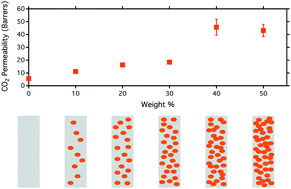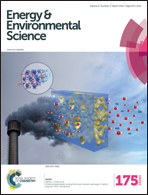Enhanced permeation arising from dual transport pathways in hybrid polymer–MOF membranes†
Abstract
The rise of anthropogenic global warming has sparked new interest in developing strategies to mitigate carbon dioxide emissions. Conventional carbon capture processes are not economically viable at scale due to their enormous energy cost. Membrane-based separation is a promising alternative, but its separation performance has traditionally been limited by a well-known trade-off between permeability and selectivity. Here, we report a hybrid polymer/inorganic membrane with dual transport pathways, which allows us to overcome this traditional limitation. The inorganic phase consists of a metal–organic framework (MOF), which is an ideal inorganic dispersant to construct dual transport pathways as the crystalline porous structure of MOFs is more amenable to molecular diffusion than polymers. Previous hybrid membrane research has failed to achieve sufficiently high loadings to establish a percolative network necessary for dual transport, often due to mechanical failure of the membrane at high loading. Using polysulfone and UiO-66-NH2 MOF as a model system, we achieve high MOF loadings (50 wt%) and observe the evolution from single mode to dual transport regimes. The newly formed percolative pathway through the MOF, which has not previously been observed, acts as a molecular highway for gases. As the MOF loading increases to 30 wt%, CO2 permeability increases linearly from 5.6 barrers in polysulfone homopolymer to 18 barrers. Crucially, between 30 and 40 wt%, a percolative MOF network arises and the CO2 permeability dramatically rises from 18 to 46 barrers; an eight-fold increase over pure polysulfone, while maintaining selectivity over methane and nitrogen near the pure polymer at 24 and 26, respectively. A similar phenomenon is observed in the measurement of the diffusion coefficient and is consistent with the formation of dual transport pathways. The findings in this study enable new approaches towards designing hybrid membranes with dual transport pathways. This is an important step towards a competitive membrane-based carbon capture process.


 Please wait while we load your content...
Please wait while we load your content...